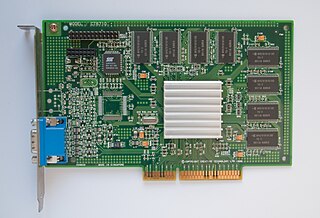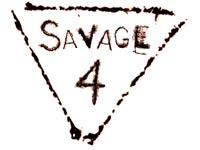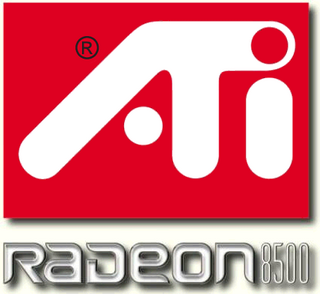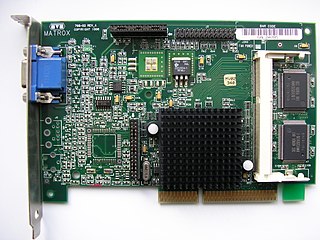
The GeForce 256 is the original release in Nvidia's "GeForce" product line. Announced on August 31, 1999 and released on October 11, 1999, the GeForce 256 improves on its predecessor by increasing the number of fixed pixel pipelines, offloading host geometry calculations to a hardware transform and lighting (T&L) engine, and adding hardware motion compensation for MPEG-2 video. It offered a notable leap in 3D PC gaming performance and was the first fully Direct3D 7-compliant 3D accelerator.

The GeForce 2 series (NV15) is the second generation of Nvidia's GeForce line of graphics processing units (GPUs). Introduced in 2000, it is the successor to the GeForce 256.

3dfx Interactive, Inc. was an American computer hardware company headquartered in San Jose, California, founded in 1994, that specialized in the manufacturing of 3D graphics processing units, and later, video cards. It was a pioneer in the field from the late 1990s to 2000.

The RIVA 128, or "NV3", was a consumer graphics processing unit created in 1997 by Nvidia. It was the first to integrate 3D acceleration in addition to traditional 2D and video acceleration. Its name is an acronym for Real-time Interactive Video and Animation accelerator.

The RIVA TNT, codenamed NV4, is a 2D, video, and 3D graphics accelerator chip for PCs that was developed by Nvidia and released in March 1998. It cemented Nvidia's reputation as a worthy rival within the developing consumer 3D graphics adapter industry. It succeeded the RIVA 128.

The RIVA TNT2 is a graphics processing unit manufactured by Nvidia starting in early 1999. The chip is codenamed "NV5" because it is the 5th graphics chip design by Nvidia, succeeding the RIVA TNT (NV4). RIVA is an acronym for Real-time Interactive Video and Animation accelerator. The "TNT" suffix refers to the chip's ability to work on two texels at once. Nvidia removed RIVA from the name later in the chip's lifetime.

The Voodoo 5 was the last and most powerful graphics card line that was released by 3dfx Interactive. All members of the family were based upon the VSA-100 graphics processor. Only the single-chip Voodoo 4 4500 and dual-chip Voodoo 5 5500 made it to market.
PowerVR is a division of Imagination Technologies that develops hardware and software for 2D and 3D rendering, and for video encoding, decoding, associated image processing and DirectX, OpenGL ES, OpenVG, and OpenCL acceleration. PowerVR also develops AI accelerators called Neural Network Accelerator (NNA).

Savage was a product-line of PC graphics chipsets designed by S3.

The R200 is the second generation of GPUs used in Radeon graphics cards and developed by ATI Technologies. This GPU features 3D acceleration based upon Microsoft Direct3D 8.1 and OpenGL 1.3, a major improvement in features and performance compared to the preceding Radeon R100 design. The GPU also includes 2D GUI acceleration, video acceleration, and multiple display outputs. "R200" refers to the development codename of the initially released GPU of the generation. It is the basis for a variety of other succeeding products.

Diamond Multimedia is an American company that specializes in many forms of multimedia technology. They have produced graphics cards, motherboards, modems, sound cards and MP3 players; however, the company began with the production of the TrackStar, a PC add-on card which emulated Apple II computers. They were one of the major players in the 2D and early 3D graphics card competition throughout the 1990s and early 2000s.

Rendition, Inc., was a maker of 3D computer graphics chipsets in the mid to late 1990s. They were known for products such as the Vérité 1000 and Vérité 2x00 and for being one of the first 3D chipset makers to directly work with Quake developer John Carmack to make a hardware-accelerated version of the game (vQuake). Rendition's major competitor at the time was 3Dfx. Their proprietary rendering APIs were Speedy3D and RRedline.

The R300 GPU, introduced in August 2002 and developed by ATI Technologies, is its third generation of GPU used in Radeon graphics cards. This GPU features 3D acceleration based upon Direct3D 9.0 and OpenGL 2.0, a major improvement in features and performance compared to the preceding R200 design. R300 was the first fully Direct3D 9-capable consumer graphics chip. The processors also include 2D GUI acceleration, video acceleration, and multiple display outputs.

The Radeon R100 is the first generation of Radeon graphics chips from ATI Technologies. The line features 3D acceleration based upon Direct3D 7.0 and OpenGL 1.3, and all but the entry-level versions offloading host geometry calculations to a hardware transform and lighting (T&L) engine, a major improvement in features and performance compared to the preceding Rage design. The processors also include 2D GUI acceleration, video acceleration, and multiple display outputs. "R100" refers to the development codename of the initially released GPU of the generation. It is the basis for a variety of other succeeding products.

The ATI Rage is a series of graphics chipsets developed by ATI Technologies offering graphical user interface (GUI) 2D acceleration, video acceleration, and 3D acceleration developed by ATI Technologies. It is the successor to the ATI Mach series of 2D accelerators.
The G400 is a video card made by Matrox, released in September 1999. The graphics processor contains a 2D GUI, video, and Direct3D 6.0 3D accelerator. Codenamed "Toucan", it was a more powerful and refined version of its predecessor, the G200.

The G200 is a 2D, 3D, and video accelerator chip for personal computers designed by Matrox. It was released in 1998.

The Voodoo2 is a set of three specialized 3D graphics chips on a single chipset setup, made by 3dfx. It was released in February 1998 as a replacement for the original Voodoo Graphics chipset.

The R300 GPU, introduced in August 2002 and developed by ATI Technologies, is its third generation of GPU used in Radeon graphics cards. This GPU features 3D acceleration based upon Direct3D 9.0 and OpenGL 2.0, a major improvement in features and performance compared to the preceding R200 design. R300 was the first fully Direct3D 9-capable consumer graphics chip. The processors also include 2D GUI acceleration, video acceleration, and multiple display outputs.
The R200 is the second generation of GPUs used in Radeon graphics cards and developed by ATI Technologies. This GPU features 3D acceleration based upon Microsoft Direct3D 8.1 and OpenGL 1.3, a major improvement in features and performance compared to the preceding Radeon R100 design. The GPU also includes 2D GUI acceleration, video acceleration, and multiple display outputs. "R200" refers to the development codename of the initially released GPU of the generation. It is the basis for a variety of other succeeding products.




















